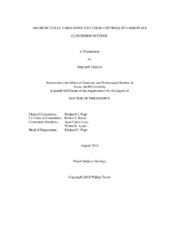| dc.contributor.advisor | Pope, Michael C | |
| dc.contributor.advisor | Reece, Robert S | |
| dc.creator | Tesch, Philipp | |
| dc.date.accessioned | 2020-09-09T18:27:43Z | |
| dc.date.available | 2020-09-09T18:27:43Z | |
| dc.date.created | 2018-08 | |
| dc.date.issued | 2018-08-03 | |
| dc.date.submitted | August 2018 | |
| dc.identifier.uri | https://hdl.handle.net/1969.1/188954 | |
| dc.description.abstract | Focus of this dissertation was to employ seismic geomorphology in the subsurface of the Browse Basin (Australia) and digital outcrop modeling in the Last Chance Canyon (New Mexico) outcrops to develop new analytical quantification and visualization techniques in the investigation of carbonate clinoform systems in 3D and 4D to extract information on the interplay of allogenic and autogenic controls that shape carbonate system architecture and evolution.
Integration of seismic geomorphology and trajectory analysis of the Oligo-Miocene distally steepened carbonate ramp system in the subsurface Browse Basin of the Northwest Shelf of Australia introduces a new way to parameterize carbonate slope channel systems and their stability. We introduce the cumulative channel cross sectional area parameter as the product of number of slope channels, slope channel depth, and slope channel width. This parameter quantifies the capability of the slope channel system to transport sediment basinward, highlights phases of autogenic slope system re-organization in response to changes in relative sea level, and can be used as a proxy for slope system stability. Introduction of our shelf break rugosity and shelf break trajectory rugosity parameters revealed the role of large-scale and intermediate scale controls on the system architecture and evolution: allogenic forcing through regional tectonics and relative sea level changes serve as main control on basin architecture and large-scale progradation and aggradation in the system. The autogenic response of the carbonate factory serves as main control on intermediate-scale and small-scale by the incision of
channels into the slope and the smoothing effect of carbonate deposition on areas that are highly rugose.
Based on our modeling results, the mixed carbonate-siliciclastic clinoform system in Last Chance Canyon, NM represents a paleo-topographic low that served as a preferential pathway for siliciclastic sediment during fifth-order relative sea level lowstands. In contrast to the traditional model of reciprocal sedimentation that infers a basin-wide carbonate factory shut-off during third-order relative sea level lowstand, we propose a modification to the reciprocal sedimentation model that integrates our outcrop observations and modeling results of the fifth-order parasequences and includes uninterrupted carbonate production in a “refugio” position, away from the avenues of sand input. | en |
| dc.format.mimetype | application/pdf | |
| dc.language.iso | en | |
| dc.subject | seismic geomorphology | en |
| dc.subject | clinoforms | en |
| dc.subject | carbonate ramp | en |
| dc.subject | trajectory analysis | en |
| dc.subject | Cenozoic | en |
| dc.subject | Permian | en |
| dc.subject | North West Shelf Australia | en |
| dc.subject | mixed carbonate-siliciclastic clinoforms | en |
| dc.subject | lateral variability | en |
| dc.subject | Permian Upper San Andres Formation | en |
| dc.subject | digital outcrop modeling | en |
| dc.subject | sequence stratigraphy | en |
| dc.subject | carbonate clinoforms | en |
| dc.title | Architectural Variations and Their Controls in Carbonate Clinoform Systems | en |
| dc.type | Thesis | en |
| thesis.degree.department | Geology and Geophysics | en |
| thesis.degree.discipline | Geology | en |
| thesis.degree.grantor | Texas A&M University | en |
| thesis.degree.name | Doctor of Philosophy | en |
| thesis.degree.level | Doctoral | en |
| dc.contributor.committeeMember | Laya, Juan Carlos | |
| dc.contributor.committeeMember | Ayers, Walter B | |
| dc.type.material | text | en |
| dc.date.updated | 2020-09-09T18:27:44Z | |
| local.etdauthor.orcid | 0000-0001-7435-5400 | |


